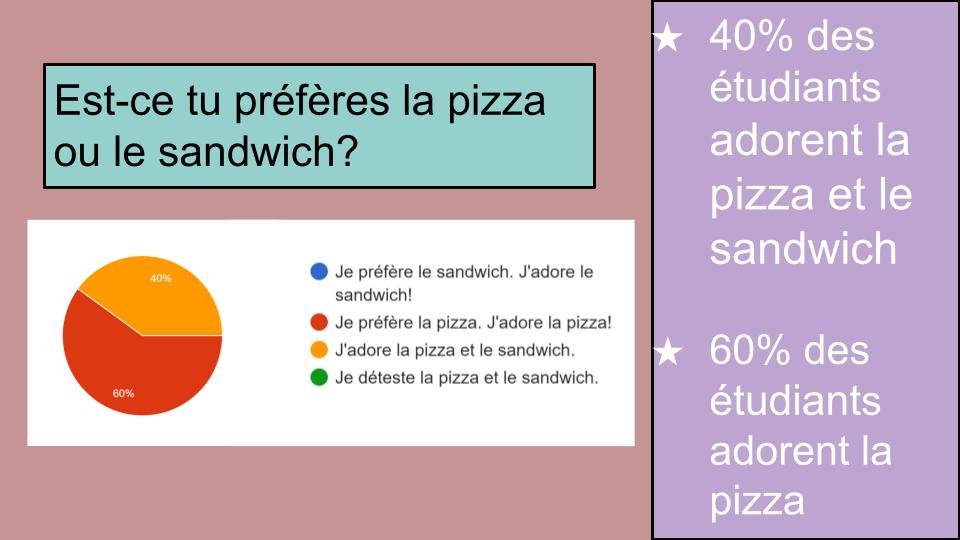Using Social Media Quizzes in your World Language Classroom
A one-stop instructional tool for reading, writing, listening, speaking, grammar, and tech integration!
“Mom, what does e-m-b-l-a-z-o-n-e-d spell?”
My 10-year-old daughter eagerly awaited my reply. “Emblazoned”, I told her.
“What does that mean?”
“It means ‘boldly decorated,’ like a big logo.
Ohhhh! Like on a super hero’s costume. That makes sense!” Katherine turned back to her tablet.
After answering questions about ‘infamous’, ‘verdant’, and ‘sedentary’; I was curious. “What are you reading?
“Online quizzes! This one is telling me what outfit I should wear tomorrow!” Katherine could hardly contain her enthusiasm. “I’ve done a lot of food ones, and ones that reveal your true favorite color, and ‘What animal are you,” and ‘Where should you go on vacation?” It’s interesting to see what they think - and it’s really fun to see how wrong they are! Then I have to go take the quiz again and see if I can get a better answer!”
“If online quizzes can motivate reluctant elementary learners, why not use them in world language classes?”
My daughter is not an avid reader, but she had been working hard to read these silly social media quizzes for over 45 minutes. She was being exposed to challenging vocabulary in a high-context, high-interest format, and she was clearly reading content above her typical reading level. Katherine even told me, “Sometimes the question is hard to read. So, I either get help, or try my best to pick an answer I can understand.”
All of this got me thinking…if online quizzes are so motivating for my reluctant-reader elementary learner, why not use them in my world language classes? I’ve since had success using target language surveys for all four language modes (reading, writing, listening, and speaking), along with contextualized grammar instruction AND some easy tech integration. Yes, this amazing, engaging tool does it all! Here’s how:
Reading comprehension
Online surveys are a fun tool for target-language reading instruction. Target language surveys:
Are available in a variety of proficiency levels, ranging from simple words and phrases to sophisticated and technical language.
Include lots of context, including images.
Are interactive
Encourage students to make inferences and experiment with language.
May Include slang, casual language, text language, etc.
Are available on a variety of high-interest and pop culture topics.
Are a familiar format for many students.
All of this creates an ideal environment for reading comprehension activities. Students will work hard to understand the questions, answer choices, and their survey results.
Writing Instruction (with a little contextualized grammar)
Have students write a short reflection in the target language about their personal quiz results and whether or not they agree.
Teach kids to find wording from within the survey to help articulate their ideas. Expressing ideas like “You are adventurous, brave, and have a healthy disregard for the rules…” are phrases that regularly come up in online survey results and are a motivating technique to build vocabulary.
For intermediate students practice writing in past, present, and conditional tenses. For example, kids could write something like: “The survey said I should visit Venice because I love tranquility and appreciate art. I would like to visit Italy, but only if I could….”
For novice students, teach a few sentence starters and encourage them to write a simple statement of agreement. “The survey said I am ____ I agree / disagree because ____” They can fill in the blanks with wording from the survey and brief personal descriptors.
Writing original surveys to administer to classmates is a natural extension of this activity. First, in class we examine target language surveys to identify words and phrases to create questions. Then, we write our own simple survey questions. This exercise works even in beginning language classes: kids can write multiple choice questions like:
What is your favorite class? (list 4 choices using “I love…)
Which restaurant do you prefer? (list 4 choices using “I prefer…)
Where would you like to go on Saturday? (give 4 choices using “I want to go…”)
This is a great place to emphasize the grammar distinction between first and second person verbs; the question will be phrased using “you” as subject, and the answer choices will use “I”. For example:
Quelle classe est-ce que tu aimes? J’aime les maths / J’aime l’anglais / etc.
¿Qué clase prefieres? Prefiero la clase de…
In French, where question formation is a bit tricky, writing survey questions is a great opportunity to practice using est-ce que or inversion.
Kids enjoy this activity and work hard to communicate interesting, creative questions in the target language.
Speaking, Listening, and a little bit of Tech
Once our survey questions are finalized, I like to teach kids how to create a Google Form to administer their surveys. Then, the survey author reads their survey aloud in the target language to a specified number of classmates, recording their responses on the Google Form. This incorporates quite a bit of speaking and listening, and kids are generally eager to share their surveys! Note: One challenge is convincing kids to speak/listen and not just hand their written survey to classmates. I address this directly with students and share the “why”. At the end of the day, improving speaking is our main goal! I ask for cooperation in making this a speaking and listening activity. When presented this way, most students do their best.
Writing, Grammar in context, and a little more Tech
Summarizing their survey results is useful for writing different verb forms in context. This novice student used three different verb forms on her summary slide.
When surveys have been administered, I show kids how to find data charts on their Google form. We copy these charts and paste them into a slideshow. To wrap up the activity, students write some summary statements like “8 students prefer KFC, but 4 students like Burger King. 1 student likes McDonalds.” These statements are a great way to highlight different verb conjugations (3rd person plural vs. singular) and can be written in present or past tenses for intermediate students.
Tips for finding and implementing Target Language Surveys
To find websites that offer interactive surveys, search a question in your target language. Questions such as ‘Which super hero are you?” or “Which Harry Potter character are you? “ will yield good results. I’ve listed a few French language survey sites below, and if you know sites for other languages, please share in the comments!
The vocabulary in the online surveys can range from simple phrases with visuals to extremely sophisticated. Find a quiz that suits your students’ learning level, or scaffold appropriately.
Some ambiguity is OK, and students don’t have to understand every word. Encourage them to make guesses and try different responses.
Be sure to preview every survey! Not all are school appropriate, and some sites have a lot of ads.
Teach students to go back to the text for vocabulary and phrasing.
Invite kids to help you search for quizzes or to choose their own.
Kids may want to retake the quiz. That’s a good thing!
Here are a Few French online quiz sites…
www.quizz.biz has French language, user-created quizzes on lots of topics. The website interface is fairly simple, and a lot of the quizzes are accessible for novice learners.
www.topito.com is a more polished website with lots of good quizzes for novice-high and intermediate-low learners.
www.demotivateur.fr/quiz Has beautiful graphics and more sophisticated language for intermediate and higher learners.
… and a few quizzes I like to use with my students:
"Quel animal es-tu?" is a straightforward, 6 question quiz that is accessible for novice French students.
“Quelle saison es-tu?” is another winner for novice French learners. Most questions are easily answered by beginners (and we work through the tough ones together). The user comments are easy to understand too.
“Quelle matière scolaire te corresponde?” is a little tougher as far as vocabulary, but still has a lot of visual support for novice learners. The cultural component (such as references to the Bac S / Bac ES / Bac L and slang related to school performance) are a natural way to open discussion with your classes
“Teste de portrait robot” This quiz creates a ‘portrait robot’ from inputted data, and claims to be based on software used by law enforcement. It’s actually a practical joke and always garners memorable reactions. The questions include more detailed physical descriptions (words like ‘étroit,’ ‘carré’, etc.) Unfortunately, the site is a little glitchy and has a lot of ads, so I usually walk kids through it. The end result never fails to shock my students and give everyone a good laugh.
“Qui es-tu en fonction de tes courses au supermarché?” This quiz is appropriate for kids with a little more French under their belts. There’s enough high frequency words and images to figure out what’s going on, along with some good new vocabulary and a bit of culture related to grocery shopping. (Note: this survey contains some images of alcohol)
Quel Saucisson es-tu? Intermediate students will enjoy this hilarious quiz. You’ll appreciate all the good-to-analyze phrases like, “Comment demandes-tu le saucisson à ton voisin de table?” with answers of varying degrees of formality, and “Si le saucisson était un animal, ce serait….”, a memorable example of imparfait & conditional tenses. (Best answer: “Un alligator albino; sévère, mais juste”). Your kids will enjoy this one! Here’s a link to the original “Quel saucisson es-tu?” online quiz. Since some of the results are not school-appropriate, as I unfortunately learned while presenting this quiz to a group of colleagues (OOPS!), I created a school-appropriate Google Form version that you’re welcome to use. It has all the charm of the original, minus the trashy innuendo! If you’d like an editable copy, e-mail me and I’ll share!
That’s just a starting point
Turn your students loose and be amazed at their learning! How have you used online surveys in your world language classes? Let us know in the comments, and don’t forget to share your favorite quiz sites!.




